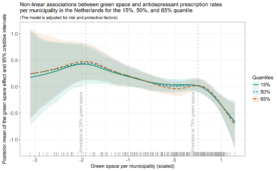News
Does green space decrease antidepressant prescriptions?
Exposure to green space seems to be beneficial for self-reported mental health. In this study we used an objective health indicator, namely antidepressant prescription rates. Current studies rely exclusively upon mean regression models assuming linear associations. It is, however, plausible that the presence of green space is non-linearly related with different quantiles of the outcome antidepressant prescription rates. These restrictions may contribute to inconsistent findings.
Our aim was: a) to assess antidepressant prescription rates in relation to green space, and b) to analyze how the relationship varies non-linearly across different quantiles of antidepressant prescription rates. We used cross-sectional data for the year 2014 at a municipality level in the Netherlands. Ecological Bayesian geoadditive quantile regressions were fitted for the 15%, 50%, and 85% quantiles to estimate green space–prescription rate correlations, controlling for physical activity levels, socio-demographics, urbanicity, etc.

The results suggested that green space was overall inversely and non-linearly associated with antidepressant prescription rates. More important, the associations differed across the quantiles, although the variation was modest. Significant non-linearities were apparent: The associations were slightly positive in the lower quantile and strongly negative in the upper one.

Our findings imply that an increased availability of green space within a municipality may contribute to a reduction in the number of antidepressant prescriptions dispensed. Green space is thus a central health and community asset, whilst a minimum level of 28% needs to be established for health gains. The highest effectiveness occurred at a municipality surface percentage higher than 79%. This inverse dose-dependent relation has important implications for setting future community-level health and planning policies.

